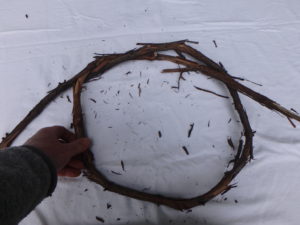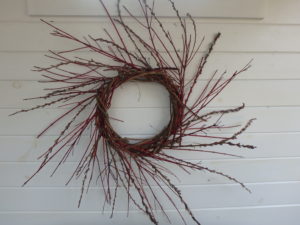How to Make a Spring Wreath
Posted on Tuesday, March 17, 2020 · Leave a Comment
The world seems to be in turmoil. Recent news is disconcerting at best. But I stay cheerful, and you can too, by being creative and/or by enjoying the outdoors. Being outside always perks me up. I love looking at my snowdrops, winter aconite and crocus. For creativity, I recently went out to collect materials for a spring wreath, then made one. I’m happy every time I look at it.
The wreath I made recently uses material from just 3 plants, though others can also be used. Here is what you need:
Several lengths of freshly cut grape vines, each piece 5 to 15 feet long and a quarter to a half an inch in diameter. Thicker vines are hard to work with. It is important to use living, not dead, vines; those I cut were a greenish white inside and flexible, so I knew they were alive. Dead vines are brittle and not suitable.
About 50 stems of red-twigged dogwood. Young stems 18 to 24 inches long with bright color are best. Branching stems are good, too.
About 25 stems of pussywillow. If the gray “pussies” are not fully open, place the stems in a vase in a warm place for a day to two and they will open up, getting fuzzier.

Wreath base ready for twigs
Begin by forming a vine circle 14 to 16 inches in diameter by overlapping (or twisting) one half of the vine over the other half – the same way you would start tying your shoelaces. Then grasp one of the sections of vine and weave it around the vine circle in loops, over and under, pulling it tight as you go. After each piece of vine is in place, squeeze the circle to make it a nice circle.
When you run out of vine, tuck the end into the circle and repeat the maneuver with the other part of the vine. Then use shorter, thinner pieces of vine – say 6 to 8 feet long and pencil-thick – and weave them around the wreath base until you have a circle about 2 inches thick.
The great thing about this grapevine wreath is that you don’t have to tie the decorative stems with wire, the way you do an evergreen Christmas wreath. You can just slide stems of pussywillows in between the vines and natural tension will hold them in place. In fact, I had to use a screwdriver to lift the vines at times in order to slide the stems in place.

Finished wreath looks great on a wall
I went around first with the red dogwood stems, poking them into the grape vine wreath every couple or inches, and almost parallel to the grape vines (not perpendicular). I wanted about 12 inches of stem coming out of the wreath and 6 inches woven into the grape vines and other stems. Both willows and dogwoods are flexible and easy to work with. I snipped the ends to a point with pruners to make it easier to insert them between the vines.
Then I added stems of pussywillow, poking them into open spaces in the grapevines, or using a screwdriver to open a space for my stems. When it was nearly done I hung the wreath up where I could work on it and was better able to see where there were gaps that needed twigs, and added a few more.
Where can you source the material for your wreath? If you don’t grow domestic grapes, look in your woods. Wild grapes climb trees in hardwood forests. You can pull them down and cut them up without guilt – they can choke out nice trees if they get big enough.
Red-twigged dogwood grows wild, often along roadside ditches and wet places. If the town road crew mows them down in mid-summer, they will be perfect – young and bright red. Older stems are a grayish red, and not as interesting.
I use a cut-and-hold pole pruner for collecting anything that grows in a swamp (dogwoods, pussywillows and later, winterberry). The pruner will grab the stem at the same time it cuts it, so I don’t get wet retrieving the stems (and even the most obedient Labrador retriever will not bring the stems to you). I got mine from The Wildflower Seed & Tool Company (
www.wildflower-seed.com or 800-456-3359).
Everyone should grow pussywillows. They are good for the soul at this time of year. The type I used in my wreath is called Japanese fantail or dragon willow, Salix udensis ’Sekka’. It is hardy to Zone 4, surviving temperatures as low as minus 30 degrees. It, and 150 other varieties, are available from Vermont Willow Nursery (https://www.willowsvermont.com). By the way, the nursery is for sale, along with 50 acres and a farm house, if you’re interested.
Fantail willow grows to be 10 to 15 feet tall and wide. They are fast-growing and I’ve read that, like most willows, they are weak-wooded and prone to breakage. I have not had any breakage on mine, however. The bark is a nice reddish-brown and quite handsome. They produce huge numbers of those fuzzy blossoms we love.

Finished wreath looks great on a wall
My finished wreath was about 36 inches in diameter, for placement on a wall, not a door. If you want a wreath for the door, you should use shorter stems. So go pick materials for a wreath. They’re quite easy to make, and sweet to the eye.
Henry has been a UNH Master Gardener for over 20 years, and is the author of 4 gardening books. Reach him at P.O. Box 364, Cornish Flat, NH 03746.





